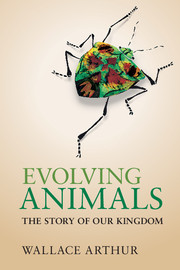Book contents
- Frontmatter
- Dedication
- Contents
- Preface
- Acknowledgements
- 1 What is an animal?
- 2 Before there were animals
- 3 How to make a fossil
- 4 The Cambrian explosion
- 5 How to make a species
- 6 Jellyfish and their kin
- 7 How to make a tree
- 8 The enigmatic urbilaterian
- 9 Animal symmetry and heads
- 10 A plethora of worms
- 11 Trends in animal complexity
- 12 Where the octopus is king
- 13 How to make an animal
- 14 Exoskeletons galore
- 15 Extinction
- 16 Mouth first, mouth second
- 17 Comparing embryos
- 18 Larvae, mouthparts and moulting
- 19 The animal toolkit
- 20 Vertebrate origins and evolution
- 21 From water to land to water
- 22 Variation and inheritance
- 23 Evolutionary novelties
- 24 Human origins and evolution
- 25 Animal plasticity
- 26 The nature of adaptation
- 27 The direction of evolution
- 28 Animal extremophiles
- 29 Extraterrestrial animals?
- 30 The ghost in the machine
- Appendix
- References
- Index
20 - Vertebrate origins and evolution
Published online by Cambridge University Press: 05 August 2014
- Frontmatter
- Dedication
- Contents
- Preface
- Acknowledgements
- 1 What is an animal?
- 2 Before there were animals
- 3 How to make a fossil
- 4 The Cambrian explosion
- 5 How to make a species
- 6 Jellyfish and their kin
- 7 How to make a tree
- 8 The enigmatic urbilaterian
- 9 Animal symmetry and heads
- 10 A plethora of worms
- 11 Trends in animal complexity
- 12 Where the octopus is king
- 13 How to make an animal
- 14 Exoskeletons galore
- 15 Extinction
- 16 Mouth first, mouth second
- 17 Comparing embryos
- 18 Larvae, mouthparts and moulting
- 19 The animal toolkit
- 20 Vertebrate origins and evolution
- 21 From water to land to water
- 22 Variation and inheritance
- 23 Evolutionary novelties
- 24 Human origins and evolution
- 25 Animal plasticity
- 26 The nature of adaptation
- 27 The direction of evolution
- 28 Animal extremophiles
- 29 Extraterrestrial animals?
- 30 The ghost in the machine
- Appendix
- References
- Index
Summary
Having a special interest in our own evolutionary origins is hard to avoid. As noted in Chapter 16, this interest can be indulged at a variety of levels, and on multiple timescales. For example, at the level of the species we can ask how Homo sapiens arose from other species of Homo over the last few million years – this is the focus of attention in Chapter 24. At a much higher level, we can ask how the bilaterian animals, of which we are one, arose hundreds of millions of years ago (Chapter 8). In between, but closer to the latter than to the former in terms of geological time, we can ask how the vertebrates began.
The earliest vertebrate fossils found so far are from the Cambrian period, and specifically from about 530 million years ago (MYA). As ever, the earliest fossils of a particular group set a latest possible date for the origin of the group concerned, but we would usually expect its actual origin to be earlier. The trouble is that it’s hard to do more than guess how much earlier. The first vertebrates may have lived in the very earliest part of the Cambrian – around 540 MYA – but there may have been vertebrates even earlier still, in the Ediacaran period (635–542 MYA).
- Type
- Chapter
- Information
- Evolving AnimalsThe Story of our Kingdom, pp. 201 - 211Publisher: Cambridge University PressPrint publication year: 2014



